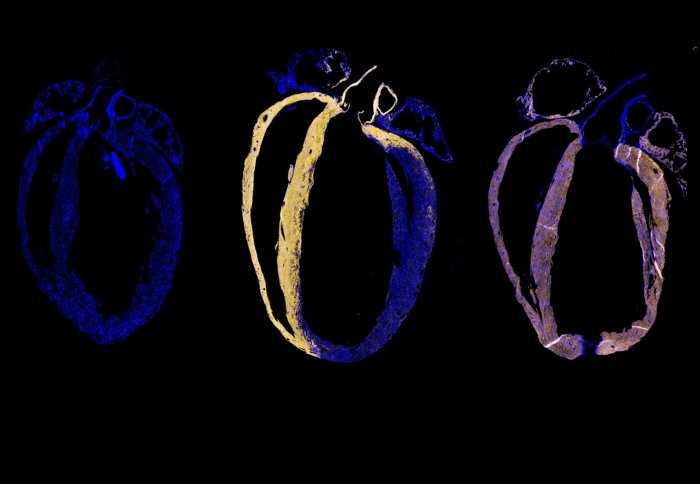Scientists identify stem cell injection that could mend broken hearts
by Sam Wong

Researchers have identified stem cells that help repair the damage caused by a heart attack when injected in mice.
In the last decade, stem cells isolated from the heart have demonstrated potential for encouraging the heart to repair itself – an approach called regenerative medicine. But there has been uncertainty among researchers about the best type and combination of stem cells.
In research published in Nature Communications, a team from Imperial College London has discovered a particular type of stem cell that could have the most potential yet for heart regenerative medicine.
The findings showed that mice treated with these stem cells were able to recover and repair a significant proportion of their damaged heart muscle after 12 weeks, preventing heart failure, when compared to mice who had not received the stem cell treatment.
This study discovered that stem cells with heart repairing properties carry an identifying protein on their surface, called PDGFR alpha. The scientists were able to use this protein to find, purify and multiply enough of these stem cells so that they could be injected into damaged hearts.
The researchers now hope to find a similar cell in human hearts, using PDGFR alpha and other proteins to identify and purify the best stem cells to repair the damage caused by heart attacks.

Professor Schneider's lab uses a robot to grow heart cells in culture.
The study was led by British Heart Foundation Professor Michael Schneider and Dr Michela Noseda at the National Heart & Lung Institute at Imperial College London. Professor Schneider said: “We have found stem cells in the heart that have a specific protein – called PDGFR alpha – on their surface have the greatest potential to repair damaged hearts.
“When we injected stem cells with this protein into damaged hearts, we saw a significant level of heart repair. Now that we know which stem cells to use, we want to find their equivalent in human hearts for more efficient heart repair and regeneration after heart attacks.
“Future treatments could be injections of stem cells, as in our current experiments, or use of the healing proteins that these cells make.”
During a heart attack, the heart is starved of oxygen and suffers damage that can never be repaired. Over time, this damage can lead to heart failure, which affects over half a million people in the UK.
Heart failure – when the heart is damaged, becomes weak and cannot pump properly – is a debilitating condition that leaves sufferers unable to climb stairs, wash themselves or carry out simple tasks. In its severest form, heart failure is a terminal illness and the only cure is a heart transplant.
Professor Jeremy Pearson, Associate Medical Director at the BHF, which part-funded the study, said: “This research is an early but important step towards understanding how we might be able to encourage stem cells in failing hearts to repair the damage caused by a heart attack. It represents one of the many ways in which scientists funded by our Mending Broken Hearts Appeal are approaching the problem of heart regeneration.
“A crucial next step for this research will be to establish if the human heart has similar heart-repairing stem cells to those pinpointed by this method in mice.”
The British Heart Foundation Mending Broken Hearts Appeal gives hope to those with, and at risk of, heart failure, by funding groundbreaking research into regenerative medicine to find a cure.
Three UK BHF Centres of Regenerative Medicine bring together world leading scientists in a bid to find treatments to mend broken hearts. Imperial College London, where this research took place, is part of the London-based BHF Centre of Regenerative Medicine.
This research was funded by the British Heart Foundation, the European Commission, the European Research Council, the Medical Research Council, the National Heart & Lung Institute Foundation and the Banyu Life Science Foundation International.
Reference: M. Noseda et al. 'PDGFRα demarcates the cardiogenic clonogenic Sca-1+ stem cell in adult murine myocardium.' Nature Communications, 2015. doi:10.1038/ncomms7930
Article supporters
Article text (excluding photos or graphics) © Imperial College London.
Photos and graphics subject to third party copyright used with permission or © Imperial College London.
Reporter
Sam Wong
School of Professional Development